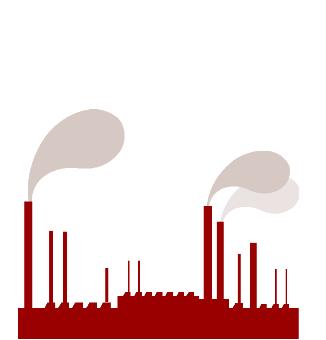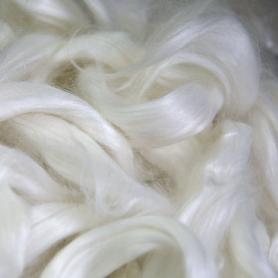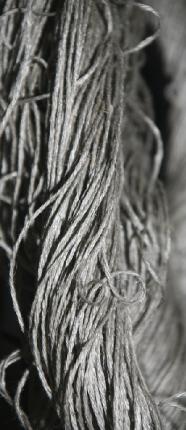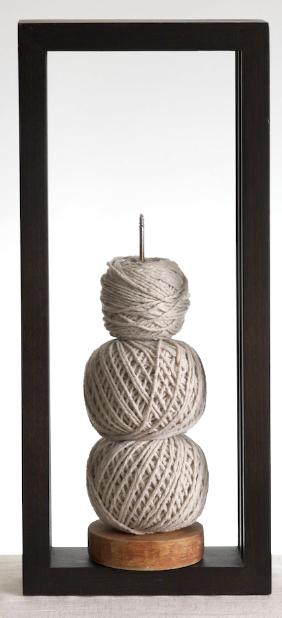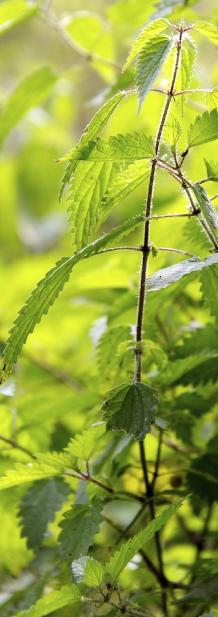 |
 |
 |
||
Bast fibres, like linen and flax are obtained from the phloem, or inner bark (or skin) of a plant. The fibres support the conductive cells of the phloem and provide strength to the stem. The fibre itself needs to be separated from the interior xylem or woody core and some times also from the epidermis which is the outer most layer of cells that carries nutrients to the leaves. The process for this separation is called retting. Bast fibre bundles are often several feet long and composed of overlapping cellulose fibres and a cohesive gum, or pectin, which strengthens the stem of the plant. The actual fibres are located between the epidermis, or bark surface, and an inner woody core. During harvesting, the plant stalks are cut off close to the base or pulled up. The fibres are then usually separated from the stalk by retting but are sometimes obtained by decortication which is a manual or mechanical peeling operation. The released fibre bundles, called strands, are frequently used without additional separation, in which case they are called fibres. Flax and ramie strands, however, are usually separated into individual fibre cells, or true plant fibres.
Water retting involves leaving the stalks in tanks or ponds of water (or in a running river), and are acted upon by bacteria, rotting the stalk which separates the fibres from the woody core. It takes 2–4 weeks for dam retting. In tanks with warm water, the time is reduced to a few days. Water retting gives a more uniform quality product. In stream retting the plants are immersed in slow moving streams for a longer time and the quality of the product is high. The nutrients from the decaying stalks means that this method is highly polluting to the water source. Dew retting is a more sustainable process where the stalks are left out in the field for 6 weeks, and are acted upon by the dew, sun and fungi. Dew retting tends to yield a dark-colored fiber. However, it is far less labor intensive and less expensive than water retting. It is commonly used in regions of low water supply. Currently dew retting is the dominant and most desirable method from a sustainability perspective. Chemical retting involves immersion of the dried plants in a tank with a solution of chemicals, such as sodium hydroxide, sodium carbonate, high pH agents, pectinolytic enzymes or mineral acids. The fibers are loosened in a few hours, but close control is required to prevent deterioration and damage to the fibres. Chemical retting is more expensive and does not produce the superior quality fibre obtained from the biological retting process. Following retting, a sequence of processes to remove the fibres from the woody stalks is carried out first by breaking them and then scraping or scutching them off which is done by beating with blunt wooden or metal blades either by hand or mechanically. Hackling is a combing process used to separate the long fibres from the short fibres and to remove the remaining woody material.
Linen Linen, or flax is the most luxurious of all the bast fibres and has a very specific tactile appeal; it is smooth and lustrous to both the eye and hand, the fibre is almost silky in texture, yet embodies a springy freshness. The quality of the final linen yarn and fabric is dependent upon the growing conditions, harvesting methods and whether it is a short fibre known as tow or the more desirable long line fibre. Linen refers to yarn and fabric made from the fibres of the stem of the flax plant. It is grown in Ireland and Northern Europe; from Southern Normandy, France to Belgium and the Netherlands, which together produce 85% of the world’s flax. The longest and more desirable flax fibres are from plants that have been hand harvested; this is the process of pulling the complete plant with root (fibres go all the way to the root) from the ground. The second best option is cutting the plant stalks very close to ground level. Flax is the only commercial cellulosic textile plant indigenous to Western Europe; it is also the strongest of all the vegetable fibres being two to three times stronger than cotton. Natural flax colours range from shades of ivory, tan and grey. White or pure white is only achieved through various bleaching processes. Flax is a renewable resource and has the potential to be much more eco friendly than cotton. It requires far less use of pesticides and artificial fertilizers. It grows best under traditional farming methods where the crops are rotated and fields are allowed to lay fallow; it also benefits from a longer lifespan. With crop rotation it is not necessary to use chemical fertilisers and pesticides when growing flax. Even when these are used flax requires only one fifth of the pesticides and artificial fertilisers that is required for commercially grown cotton. Additionally linen is up to twelve times stronger than the equivalent cotton product, which dramatically increases its life spun and therefore does not need to be replaced so often. Linen absorbs dye well, especially natural dyes and does not require chemical treatments. It can be sun bleached to avoid the use of artificial agents. Flax processing is, however labour intensive, requiring skilled workers. It also produces minimum wastage, as there are several by-products. These include linseed oil for linoleum, soap, fuel and cattle feed. It is a more expensive fibre than cotton with much more of a niche market and therefore is an ideal vehicle for organic cultivation and ecological production methods. For more information on linen, go into the Linen-Bast category.
RAMIE Ramie is a flowering plant of the nettle family boehmeria niveea that is native to Eastern Asia. It flourishes best in warm humid temperatures but is also able to withstand droughts and can achieve a life span of twenty years. There are two types of ramie; China Grass which is also known as true ramie or white ramie and green ramie which are believed to have originated in Malaysia. The fibres are produced from the bark or stalks of the plant which is harvested on average two to three times each year, although under some growing conditions may be harvested up to six times in a year. Ramie has very similar properties to linen; it is a natural white in color, has an excellent lustre and is unusually resistant to bacteria and moulds. Ramie is the longest of the vegetable fibres and has exceptional strength.
HEMP Hemp is an ecologically and sustainably important plant, running in tandem with ‘green future’ objectives and is often referred to as the World’s most useful plant. Hemp is non-toxic in use, renewable and non-polluting during its life cycle; it needs little if any pesticides, resisting decay and infestation naturally. The crops grow quickly and around 100 days after harvesting the soil is left in better condition as it has been replenished with nutrients and nitrogen. In addition it controls topsoil erosion and produces great amounts of oxygen. The seeds and stalks as well as the general fermentation of the plant produces an oil that may be used as bio diesel, and while a low energy fuel it is better than other similar crops. It can also be used for biodegradable plastics. Hemp fabric is similar to linen in both hand and appearance. Hemp fabric withstands water better than any other textile product. However, it wrinkles easily and should not be creased excessively to avoid wear and breakage of the fibers. Hemp is the generic name for the entire cannabis family of plants. The two principal plant varieties are: Cannabis sativa L. subsp. Sativa which is commonly known as Industrial hemp and is the term given to the variety grown for fibre and other non drug related purposes. Conversely Cannabis sativa L. subsp. Indica is the variety grown for both recreational and medical drug use. The principal difference between the two varieties is the level of THC (tetra hydro cannabinol) that is secreted in a resin like mixture.
Years of selective breeding have produced many different varieties. Since the 1930s the focus has been the production of strains that offer a poor sources of drug material. The plants are long and slender with fibres that are between one and five metres long running the full length of the plant. Hemp is cultivated all over the world and was such an important crop that in the 19th century over 80% of the world’s fabric was made of hemp. The United States is the only industrialised country where it is still illegal to grow hemp, although some states have granted licences for the cultivation of industrial hemp. This restriction has hampered its use as a modern commercially viable raw material. Up to the mid 1980s the old Soviet Union was the largest producer, much of it being cultivated in the Ukraine and the parts of Russia close to Poland. The world’s premier institute for the development of hemp is still situated in The Ukraine where it develops new varieties with improved fibre content, increased yield and low THC. Other important producers of hemp include: China, North Korea, Romania and Hungary. India produces a variety of hemp known as Sunn or Bombay Hemp. Canada, the United Kingdom and Germany lifted the ban in the 1990s. However, within the European Union and Canada a licence has to be issued for its cultivation. Japan, under American influence also restricted the growth of hemp in 1948 and is one of the few Eastern countries to have prohibited its cultivation. The finest qualities of hemp for fabric are now produced in Italy. Hemp fibre can also be ‘cottonised’ by a process similar to that used for flax, it is however not easy to spin but does make for a very good blend when used together with cotton in a 50-50 ratio. A new process has recently been developed that makes it possible to use the same machinery as cotton when weaving hemp. Along with flax, this fast-growing plant is now the basis for a new textile woven on conventional cotton-machinery, called CRAILARŽ Organic Fibres. Naturally Advanced Technologies Inc. (NAT), Vancouver, Canada, has granted licence to Tuscarora Yarns Inc. under which Tuscarora will design and manufacture specialty yarns containing blends of NAT's CRAILARŽ Flax fibre with cotton or other fibres. NAT expects the partnership will open avenues for the fiber's use in underexplored clothing markets such as couture fashion, sports performance and extreme weather gear. CRAILARŽ Flax is produced using an enzymatic process that converts bast fibers into materials that are as soft as cotton but more durable and eco-friendly. The production of hemp in Western countries is growing steadily to meet the growing interest in sustainable textiles. In Canada the export of hemp seeds has increased by over 300% over the last two years.
JUTE Jute or Hessian is one of the cheapest natural fibres to produce, and is the second most important vegetable fibre after cotton, in terms of production, global consumption, and availability. Jute fibres are composed of mainly cellulose but also lignin, which is a wood fibre. Jute is a long, soft, shiny vegetable fibre that can be spun into strong threads. It is one of the most affordable of all the natural fibres and is second only to cotton in quantity produced and variety of uses. The two varieties of jute are white jute corchorus capsularis or Indian jute and Tossa jute corchorus olitorius, which is Afro-Arabic jute. Tossa jute is also grown as a staple food and is now grown in India. Tossa jute is softer and silkier and more lustrous than white jute. Jute is a rain-fed crop with little need for fertilizer or pesticides. The production is concentrated in Bangladesh and some in India, mainly Bengal. Germany and Brazil also import raw jute from Bangladesh. India is the largest grower. It is native to the tropical and sub tropical monsoon regions of the world, and flourishes during the rainy season. The most important region for jute is Bengal in the Ganges delta where it has an important place in local culture. In Bangladesh it was called the “golden fibre,” as trade in jute brought the largest amount of foreign currency into the country. When demand dropped local farmers burnt their crops rather than sell at unsustainable prices, however recently there has been an increase in demand and prices have risen by more than 50%. It is high in both tensile and ductile strength. It is used in areas of internal body parts where its strength and lightness of weight make the vehicles more fuel-efficient and thus a better ecological proposition. This versatile fibre is also used for paper, film, composite materials and geotextiles in environmental engineering. As a textile fibre it blends well with both other natural fibres and synthetics and when dyed it retains colour well being both colour and light fast. Other properties include antistatic and low thermal conduction as well as offering a high level of UV protection. It is mostly used in the furnishing textile industries, however due to its durability and advantageous properties it is also now being developed for high performance technical textiles. Jute has very strong environmental credentials, as it does not require excessive watering, fertilisers or pesticides; it is a fast growing plant with a good yield ratio of fibre to weight and acreage. It can be recycled several times within its lifecycle and also has important biodegradable properties.
Kenaf Kenaf has a long history of cultivation dating back over 4000 years in parts of Africa it was also cultivated in India and Thailand. Today the major producers are China and India. It is a species of hibiscus with visual similarities to Jute. The traditional uses for kenaf have been rope, twine and coarse cloth as well as for fuel and nutrition. It is an ideal candidate for sustainable ecological cultivation, as it only requires the minimum use of pesticides and fertilizers. The emerging uses for it today span engineering applications, insulation paper and clothing grade cloth as well as providing vegetable oil from the seeds. The fibres are naturally white and do not need to undergo any bleaching processes for either paper or cloth uses. These closely related bast fibers are derived from Hibiscus cannabinus and H. sabdariffa (mallow family, Malvaceae), respectively. Plantation-grown kenaf is capable of growing from seedlings to 5 m at maturity in five months. It is reported to yield ~6–10 tons of dry matter per acre, nine times the yield of wood. Kenaf fibers are shorter and coarser than those of jute. Kenaf fiber is also considered a substitute for jute and used in sacking, rope, and bags,
BAMBOO LINEN Bamboo ‘Linen’ or ‘Silk’ Fibre Bamboo is a very-fast growing woody grass that can produce shoots of up to a metre per day. It is ready for harvesting in 4 years and does not require re-planting as the extensive root base sprouts new shoots readily, it therefore has the potential to be a highly sustainable raw material. As it is a grass species it regenerates after being cut, much like a lawn, which negates the need for replanting. This regular harvesting is of benefit to the health of the plant and studies have shown that cutting of bamboo canes leads to vigorous re-growth and an increase in the amount of biomass the following year. Very little bamboo is irrigated and there is sound evidence that the water-use efficiency of bamboo is twice that of other trees. This makes bamboo more able to handle harsh weather conditions such as drought, flood and high temperatures. There are over 1600 species of bamboo found in diverse climates from cold mountains to hot tropical regions. About 40 million hectares of the earth is covered with bamboo, mostly in Asia. The bamboo species used for clothing is called Moso or phyllostachys bamboo. This is the most important bamboo type in China, where it covers about 3 million hectares. Bamboo typically grows very densely and its clumping nature enables substantial quantities to be grown in a comparatively small area, easing pressure on land use. Yields of bamboo of up to 60 tonnes per hectare greatly exceed the yield of 20 tonnes for most trees and only 1-2 tonnes per hectare for cotton with a one-time planting for bamboo and little care and maintenance needed. This high growth rate and the ability to flourish in such diverse climates gives the bamboo plant the potential to be a highly sustainable and versatile resource. Bamboo planting can slow deforestation, providing an alternative source of timber for the construction industry and cellulose fibre for the textile industry. The extensive root system of bamboo and the fact that it is not uprooted during harvesting means bamboo actually helps preserve soil and prevent soil erosion. The root system of bamboo creates an effective watershed, stitching the soil together along fragile river banks, deforested areas, and in places prone to mudslides. It also greatly reduces rain run-off. A huge benefit of using bamboo as the organic base for textile fibres is that there is no need for pesticides or fertilisers when growing bamboo. However, herbicide and fertilizer applications are common in some places to encourage edible shoot growth. Bamboo also contains a substance called bamboo-kun, an antimicrobial agent that gives the plant a natural resistance to pest and fungi infestation. Bamboo is also extremely efficient at minimising CO2 and generates up to 35% more oxygen than equivalent stands of trees. One hectare of bamboo can sequester 62 tonnes of carbon dioxide per year while one hectare of young forest only sequesters 15 tonnes of carbon dioxide per year.
Bamboo fibre for textiles is either produced mechanically (via the retting process), or chemically (regenerated via the viscose process). In the mechanical process the woody stems are crushed and natural enzymes break down the stems so that the fibres can be combed out and spun, using similar methods to the production of flax. This is a labour-intensive process and is used to produce bamboo ‘linen’. This produces a more expensive fibre than bamboo viscose which is more widely used for contemporary clothing. Many Chinese producers of bamboo viscose continue to use caustic chemicals in their processing, negating the sustainable benefits of the raw fibre. Swiss company Litrax is, however involved in the development of sustainable manufacturing of bamboo fibre. and claims to use a more natural way of processing the bamboo into fibre. The same manufacturing process is used to produce linen fabric from flax or hemp. Bamboo fabric made from this process is sometimes called bamboo linen. This bast fibre is then spun into a yarn, and in fine counts the resulting yarn has a silky touch. The natural processing of Litrax bamboo allows the fibre to remain strong to produce an extremely high quality product, and the process results in a very durable textile. Sustainable land use practices that provide both economic and environmental advantages and are of global importance as the world’s six billion people compete for water, food, fibre and shelter, the high yield per hectare of bamboo becomes a very significant advantage. Due to its ease of cultivation, potential environmental benefits and extraordinary growth rate it is a cheap, sustainable and efficient crop.
NETTLE
Nettles have a long history as a textile fibre substitute for linen, dating back to medieval times, and have also been used commercially more recently during both World Wars, when other crops such as cotton were scarce. Research is already under way to develop the use of nettles for textiles. In 2004 a DEFRA funded project ‘Sustainable Technology in Nettle Growing’ (STING) at Leicester's De Montfort University has succeeded in extracting a silky thread that is stronger and finer than that of other plants such as hemp. Dutch company Brennels, in consultation with the De Montfort STING project is currently cultivating nettles in Holland's North-East Polder region. Today, this project has has grown to over 80 hectares. They are also cultivating nettles in both the Czech Republic and Lithuania. There is also an EU-funded project (known as FAIR-CT98-9615) that has recently been working with textile companies in Austria, Germany and Italy to develop methods of extracting fibre from nettles, as well as the spinning, weaving and manufacturing of these textiles. Nettles have the potential to be a viable alternative to cotton, and other textiles that are harmful to the environment. The future may see nettles as a crop that can transform lives for those growing textile crops in the developing world. Nettles can grow on the most inhospitable land that has been subjected to chemical abuse, but their cultivation uses a very small amount, if any at all of pesticide. The processes for making nettles into desirable and commercially viable textiles are developing all the time and offer a far more environmentally sustainable alternative to conventional cotton. |
BAST FIBRES - OTHERS
 PROCESSING
PROCESSING